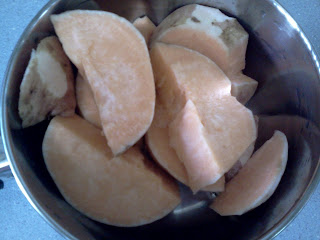This dish took about an hour to finish.
Things that Bit Bit found out about making Vegetarian Kansai-Style Okonomiyaki:
- One can add anything that one likes in okonomiyaki, so just choose one's favourite ingredients and it will turn out very yummy.
- While cooking the okonomiyaki, turn heat to low to prevent the bottom of the okonomiyaki from getting burnt and also to cook the insides thoroughly.
- Other than okonomiyaki sauce, one can also use other condiments that one likes, for example, Bit Bit likes it with ketchup, or one can use light soy sauce if one prefers a more savoury flavour.
- Okonomiyaki is a pancake made with mainly cabbage, and is crispy outside and soft in the inside. Bit Bit likes it a lot!
- All Purpose Flour - About 50gm
- Baking Powder - 1/4 Tsp
- Water - About 80ml
- Granulated Dashi - 1/8 Tsp
- Salt - A Pinch
- Cabbage - About 150gm to 200gm
- Beansprouts - 1/2 Cup
- Cheese - 1 Slice
- Ketchup - 3 Tbsp
- Vegetarian Oyster Sauce - 2 Tbsp
- Honey - 1.5 Tbsp
- Canola Oil - 1/2 Tbsp
- In a big bowl, add in flour, baking powder and salt.
- In a small bowl, add in water and granulated dashi, and mix well.
- Pour the dashi mixture into the big bowl, and mix well.
- Wash the cabbage, shred into small pieces and add into the flour mixture.
- Wash the beansprouts and add into the flour mixture.
- Tear the cheese slices into small pieces and add into the flour mixture.
- Mix the ingredients with the flour mixture well.
- Heat up a pan and grease the pan.
- Turn heat to low and pour in the okonomiyaki mixture, forming a round circle.
- Let the okonomiyaki cook for about 10 minutes, or till the bottom browns.
- Flip the okonomiyaki over and let the other side of the okonomiyaki cook for about 10 minutes, or till it browns.
- Use a spoon or spatula to press the okonomiyaki lightly, flattening it a little.
- Cook for about 3 to 5 minutes and flip it over.
- In a small bowl, mix the ketchup, honey and vegetarian oyster sauce.
- Spread the sauce mixture on the top of the okonomiyaki, while still letting the okonomiyaki cook.
- Cook for about 2 to 3 minutes more.
- Serve and eat!





































